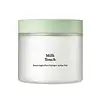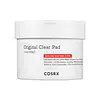What's inside
What's inside
 Key Ingredients
Key Ingredients

 Benefits
Benefits

 Concerns
Concerns

 Ingredients Side-by-side
Ingredients Side-by-side

Water
Skin ConditioningMethylpropanediol
SolventGlycerin
HumectantDipropylene Glycol
HumectantButylene Glycol
Humectant1,2-Hexanediol
Skin ConditioningHydroxyacetophenone
AntioxidantPanthenol
Skin ConditioningCaffeine
Skin ConditioningPotassium Alum
AstringentErythritol
HumectantSodium Citrate
BufferingCaprylyl Glycol
EmollientAllantoin
Skin ConditioningPolyglyceryl-10 Laurate
Skin ConditioningPropanediol
SolventEthylhexylglycerin
Skin ConditioningChlorella Vulgaris Extract
Skin ConditioningGlucose
HumectantPentylene Glycol
Skin ConditioningFructooligosaccharides
HumectantFructose
HumectantTrisodium Ethylenediamine Disuccinate
Acetyl Glucosamine
Skin ConditioningAlthaea Rosea Flower Extract
Skin ConditioningSodium Hyaluronate
HumectantSaccharomyces Ferment Filtrate
HumectantPyrus Malus Fruit Extract
Skin ConditioningSodium Hyaluronate Crosspolymer
HumectantAlbatrellus Confluens Extract
HumectantBetaine Salicylate
AntimicrobialCitric Acid
BufferingArgania Spinosa Kernel Oil
EmollientSesamum Indicum Seed Oil
EmollientRhus Semialata Gall Extract
Skin ConditioningEnantia Chlorantha Bark Extract
Skin ConditioningSerenoa Serrulata Fruit Extract
Skin ConditioningTremella Fuciformis Extract
HumectantBeta-Sitosterol
Emulsion StabilisingTocopherol
AntioxidantHydroxypropyltrimonium Hyaluronate
Hydrolyzed Collagen
EmollientOleanolic Acid
Skin ConditioningHydrolyzed Hyaluronic Acid
HumectantSodium Acetylated Hyaluronate
HumectantHyaluronic Acid
HumectantHydrolyzed Sodium Hyaluronate
Skin ConditioningPotassium Hyaluronate
Skin ConditioningWater, Methylpropanediol, Glycerin, Dipropylene Glycol, Butylene Glycol, 1,2-Hexanediol, Hydroxyacetophenone, Panthenol, Caffeine, Potassium Alum, Erythritol, Sodium Citrate, Caprylyl Glycol, Allantoin, Polyglyceryl-10 Laurate, Propanediol, Ethylhexylglycerin, Chlorella Vulgaris Extract, Glucose, Pentylene Glycol, Fructooligosaccharides, Fructose, Trisodium Ethylenediamine Disuccinate, Acetyl Glucosamine, Althaea Rosea Flower Extract, Sodium Hyaluronate, Saccharomyces Ferment Filtrate, Pyrus Malus Fruit Extract, Sodium Hyaluronate Crosspolymer, Albatrellus Confluens Extract, Betaine Salicylate, Citric Acid, Argania Spinosa Kernel Oil, Sesamum Indicum Seed Oil, Rhus Semialata Gall Extract, Enantia Chlorantha Bark Extract, Serenoa Serrulata Fruit Extract, Tremella Fuciformis Extract, Beta-Sitosterol, Tocopherol, Hydroxypropyltrimonium Hyaluronate, Hydrolyzed Collagen, Oleanolic Acid, Hydrolyzed Hyaluronic Acid, Sodium Acetylated Hyaluronate, Hyaluronic Acid, Hydrolyzed Sodium Hyaluronate, Potassium Hyaluronate
 Reviews
Reviews

Ingredients Explained
These ingredients are found in both products.
Ingredients higher up in an ingredient list are typically present in a larger amount.
1,2-Hexanediol is a synthetic liquid and another multi-functional powerhouse.
It is a:
- Humectant, drawing moisture into the skin
- Emollient, helping to soften skin
- Solvent, dispersing and stabilizing formulas
- Preservative booster, enhancing the antimicrobial activity of other preservatives
Allantoin is a soothing ingredient known for its protective and moisturizingg properties. Because of this, it is often added to products with strong active ingredients.
Studies show higher concentrations of this ingredient can promote wound healing.
Though it can be derived from the comfrey plant, allantoin is produced synthetically for cosmetic products to ensure purity.
Learn more about AllantoinBetaine Salicylate is considered a salicylic acid alternative.
Limited studies exist proving this ingredient to be a complete alternative to salicylic acid. Based on existing research, this ingredient does not penetrate as deeply and is not shown to be as effective.
However, this makes it a great choice for those with sensitive skin or need gentle BHA action.
This ingredient is created using betaine and salicylic acid.
This ingredient is oil-soluble and is most effective at a pH range of 3.8-4.2.
Learn more about Betaine SalicylateButylene Glycol (or BG) is used within cosmetic products for a few different reasons:
Overall, Butylene Glycol is a safe and well-rounded ingredient that works well with other ingredients.
Though this ingredient works well with most skin types, some people with sensitive skin may experience a reaction such as allergic rashes, closed comedones, or itchiness.
Learn more about Butylene GlycolGlycerin is already naturally found in your skin. It helps moisturize and protect your skin.
A study from 2016 found glycerin to be more effective as a humectant than AHAs and hyaluronic acid.
As a humectant, it helps the skin stay hydrated by pulling moisture to your skin. The low molecular weight of glycerin allows it to pull moisture into the deeper layers of your skin.
Hydrated skin improves your skin barrier; Your skin barrier helps protect against irritants and bacteria.
Glycerin has also been found to have antimicrobial and antiviral properties. Due to these properties, glycerin is often used in wound and burn treatments.
In cosmetics, glycerin is usually derived from plants such as soybean or palm. However, it can also be sourced from animals, such as tallow or animal fat.
This ingredient is organic, colorless, odorless, and non-toxic.
Glycerin is the name for this ingredient in American English. British English uses Glycerol/Glycerine.
Learn more about GlycerinPanthenol is a common ingredient that helps hydrate and soothe the skin. It is found naturally in our skin and hair.
There are two forms of panthenol: D and L.
D-panthenol is also known as dexpanthenol. Most cosmetics use dexpanthenol or a mixture of D and L-panthenol.
Panthenol is famous due to its ability to go deeper into the skin's layers. Using this ingredient has numerous pros (and no cons):
Like hyaluronic acid, panthenol is a humectant. Humectants are able to bind and hold large amounts of water to keep skin hydrated.
This ingredient works well for wound healing. It works by increasing tissue in the wound and helps close open wounds.
Once oxidized, panthenol converts to pantothenic acid. Panthothenic acid is found in all living cells.
This ingredient is also referred to as pro-vitamin B5.
Learn more about PanthenolSodium Hyaluronate is hyaluronic acid's salt form. It is commonly derived from the sodium salt of hyaluronic acid.
Like hyaluronic acid, it is great at holding water and acts as a humectant. This makes it a great skin hydrating ingredient.
Sodium Hyaluronate is naturally occurring in our bodies and is mostly found in eye fluid and joints.
These are some other common types of Hyaluronic Acid:
Learn more about Sodium Hyaluronate